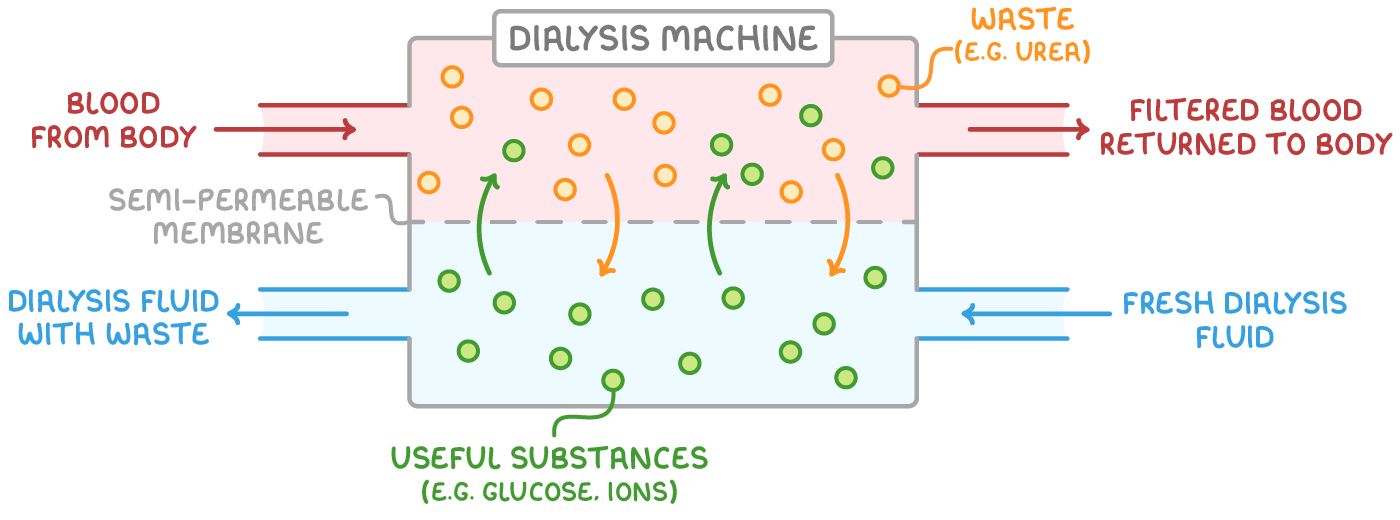Kidney Failure
This lesson covers:
- The causes, indicators, and effects of kidney failure
- Dialysis as a treatment for kidney failure
- Kidney transplants as a treatment for kidney failure
Causes of kidney failure
Kidney failure, also known as renal failure, occurs when the kidneys are unable to function effectively. This prevents them from filtering blood and eliminating waste products properly.
There are two main causes of kidney failure:
- Kidney infections - These lead to inflammation and swelling in the kidneys, damaging the cells responsible for filtering and reabsorption.
- High blood pressure - High blood pressure can damage the glomeruli capillaries, so proteins and blood leak into the urine.
Indicators of kidney failure
Glomerular filtration rate (GFR) is a measure of how much blood is filtered in the Bowman's capsules of the kidney nephrons. It can be used as an indicator of kidney failure.
GFR and creatinine as indicators of kidney failure:
- A low GFR indicates less effective blood filtration.
- A blood test can measure the level of creatinine in the blood, which is used to estimate the GFR.
- A high level of creatinine is a signal that the kidneys are not working properly and may indicate kidney disease.
Effects of kidney failure
Kidney failure can have various dangerous effects on the body. If not addressed, these can potentially lead to fatal outcomes.
Effects of kidney failure:
- Build-up of mineral ions in the blood - Causes a loss of electrolyte balance and osmotic imbalances.
- Build-up of toxic urea in the blood - Can poison cells.
- High blood pressure - May cause heart problems and strokes.
- Loss of calcium and phosphorous balance - Weakens bones.
- Build-up of abnormal proteins in the blood - Causes pain and stiffness in joints.
- Anaemia - Causes tiredness and lethargy.
Renal dialysis as a treatment for kidney failure
Renal dialysis, sometimes just called dialysis, is a process where a machine takes over the role of the kidneys to filter the blood.

How dialysis filters the blood:
- The patient's blood passes along one side of a semi-permeable membrane, while dialysis fluid flows on the other.
- Dialysis fluid contains normal plasma levels of mineral ions, so ions diffuse through the semi-permeable dialysis tubing membrane into blood until normal levels of ions are present in blood.
- Dialysis fluid contains normal plasma levels of glucose, so glucose also diffuses from dialysis fluid into blood until their concentrations of glucose are equal.
- Dialysis fluid contains no urea, so urea is removed from the blood into the dialysis fluid by diffusion.
- Larger molecules, like blood cells and proteins, remain in the blood as they are too large to pass through the semi-permeable membrane.
Types of renal dialysis
There are two types of renal dialysis that are useful to know about.
- Haemodialysis
- Blood leaves the patient's body and flows into a dialysis machine.
- Blood is filtered in the dialysis machine as described above and returned to the body.
- Peritoneal dialysis
- The peritoneum is a membrane lining the abdominal cavity.
- It acts as a surface across which substances are exchanged between blood and dialysis fluid.
- The dialysis fluid is injected into and then drained from the abdominal cavity so blood can be filtered, within the body itself.
There are several advantages and disadvantages of each type of dialysis.
| Peritoneal dialysis | Haemodialysis |
|---|---|
| No need for specialist equipment | Requires specialist equipment |
| Can be done at home by a patient | Must be done in a hospital or medical centre |
| Patient can be mobile during treatment | Patient must be immobile during treatment |
| Risk of infection | Lower risk of infection |
| Required more frequently | Required less frequently |
Kidney transplants as a treatment for kidney failure
A kidney transplant involves the surgical introduction of a healthy, donated kidney into a patient's body. While dialysis provides life-sustaining support, transplants offer a more permanent solution.
Kidney transplants have several other advantages and disadvantages when compared with dialysis:
| Advantages of kidney transplants | Disadvantages of kidney transplants |
|---|---|
| No need for regular dialysis sessions | Risk of organ rejection if the immune system recognises antigens on the donor organ as foreign and attacks it |
| No need for dietary monitoring | Shortage of donor kidneys, while dialysis is readily available |
| Prevents the build-up of waste products between dialysis sessions that can cause long-term body damage | Necessitates the use of medication to suppress the immune system |
| Generally improves quality of life | Involves major surgery with associated risks |
| One-off cost, rather than several long-term payments in dialysis |
The risk of organ rejection can be reduced by matching the antigens of the donor and recipient as closely as possible. Kidney donors are usually either living relatives or deceased individuals who have donated their organs.
Giving the recipient immunosuppressant drugs can also reduce the risk of rejection, but they prevent patients from responding effectively to infectious diseases, making them more susceptible to illness.